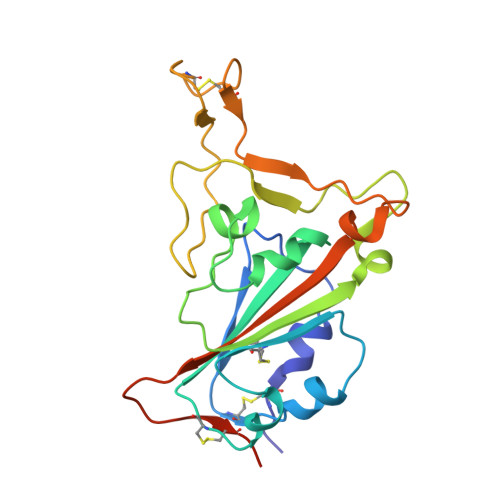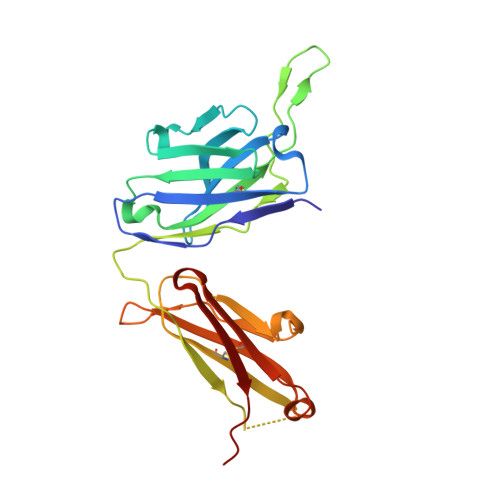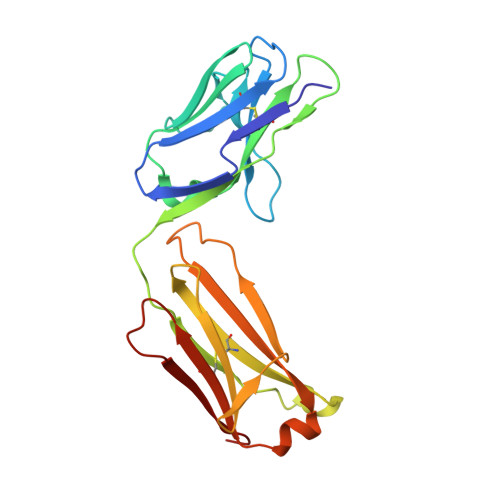Bispecific antibodies targeting distinct regions of the spike protein potently neutralize SARS-CoV-2 variants of concern.
Cho, H., Gonzales-Wartz, K.K., Huang, D., Yuan, M., Peterson, M., Liang, J., Beutler, N., Torres, J.L., Cong, Y., Postnikova, E., Bangaru, S., Talana, C.A., Shi, W., Yang, E.S., Zhang, Y., Leung, K., Wang, L., Peng, L., Skinner, J., Li, S., Wu, N.C., Liu, H., Dacon, C., Moyer, T., Cohen, M., Zhao, M., Lee, F.E., Weinberg, R.S., Douagi, I., Gross, R., Schmaljohn, C., Pegu, A., Mascola, J.R., Holbrook, M., Nemazee, D., Rogers, T.F., Ward, A.B., Wilson, I.A., Crompton, P.D., Tan, J.(2021) Sci Transl Med 13: eabj5413-eabj5413
- PubMed: 34519517
- DOI: https://doi.org/10.1126/scitranslmed.abj5413
- Primary Citation of Related Structures:
7LQ7 - PubMed Abstract:
The emergence of severe acute respiratory syndrome coronavirus 2 (SARS-CoV-2) variants of concern threatens the efficacy of existing vaccines and therapeutic antibodies and underscores the need for additional antibody-based tools that potently neutralize variants by targeting multiple sites of the spike protein. We isolated 216 monoclonal antibodies targeting SARS-CoV-2 from plasmablasts and memory B cells collected from patients with coronavirus disease 2019. The three most potent antibodies targeted distinct regions of the receptor binding domain (RBD), and all three neutralized the SARS-CoV-2 Alpha and Beta variants. The crystal structure of the most potent antibody, CV503, revealed that it binds to the ridge region of SARS-CoV-2 RBD, competes with the angiotensin-converting enzyme 2 receptor, and has limited contact with key variant residues K417, E484, and N501. We designed bispecific antibodies by combining nonoverlapping specificities and identified five bispecific antibodies that inhibit SARS-CoV-2 infection at concentrations of less than 1 ng/ml. Through a distinct mode of action, three bispecific antibodies cross-linked adjacent spike proteins using dual N-terminal domain–RBD specificities. One bispecific antibody was greater than 100-fold more potent than a cocktail of its parent monoclonals in vitro and prevented clinical disease in a hamster model at a dose of 2.5 mg/kg. Two bispecific antibodies in our panel comparably neutralized the Alpha, Beta, Gamma, and Delta variants and wild-type virus. Furthermore, a bispecific antibody that neutralized the Beta variant protected hamsters against SARS-CoV-2 expressing the E484K mutation. Thus, bispecific antibodies represent a promising next-generation countermeasure against SARS-CoV-2 variants of concern.
Organizational Affiliation:
Malaria Infection Biology and Immunity Section, Laboratory of Immunogenetics, National Institute of Allergy and Infectious Diseases, National Institutes of Health, Rockville, MD 20852, USA.



















